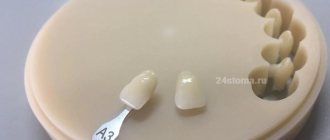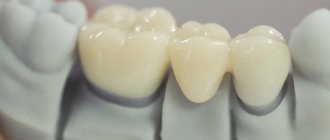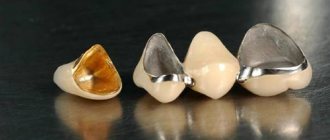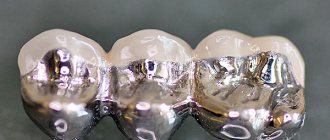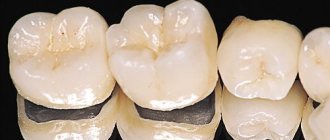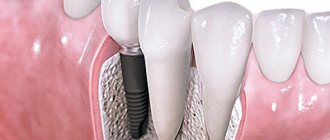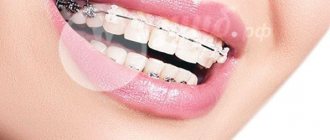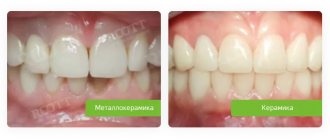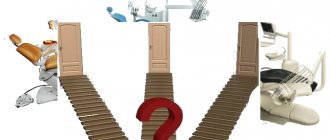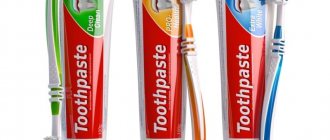30.11.2019
Tooth loss can be associated with oral diseases or old age. Sports and other injuries often lead to their loss. Whatever the reason, modern dentistry has in its arsenal enough options for individual solutions in the form of prosthetics using various materials.
Two types of dental structures are used in prosthetics
- REMOVABLE
- FIXED
Materials for making a prosthesis can be:
- Plastic – for short-term use on chewing teeth or on the front teeth, where the mechanical impact is several times less;
- Metal – considered stronger and more durable. Not suitable for people with allergies to metal. Manufactured in a one-piece version and stamped by soldering;
- Ceramics are well suited for prosthetics in those areas that are visible to others, since during manufacturing the natural color of existing teeth can be easily matched. The appearance completely reproduces the natural dentition;
- Mixed composite materials - metal-ceramics, metal-plastic.
Metal-ceramics and metal-plastic are a combined material; each of them has positive and negative characteristics. Which artificial teeth, made of metal-ceramics or metal-plastic, is best to choose? To answer this question, it is worth studying each material in detail.
Main features of metal-ceramic prostheses
This type of prosthesis is a type of solid cast structure; it consists of a metal base (frame) with ceramic lining. It is created from special alloys (zirconium dioxide, cobalt/chrome or nickel/chrome) designed specifically for dental needs. Sometimes alloys containing precious metals (gold, silver, palladium) are used to make the base. Depending on what metals the metal ceramics contain, the price of prostheses may vary.
What to give preference to?
Depending on the goals of prosthetics and the financial capabilities of the patient, dentists can install dentures made using various technologies and using a wide variety of materials. The most reliable, durable and aesthetic prostheses require the use of expensive materials for their creation. Another factor influencing the choice of material is the location of the tooth that needs restoration.
Making the right choice
The plastic used in dentistry is of high quality, perfectly recreates the structure of tooth enamel and the shade of living teeth, and is hypoallergenic. However, in a number of characteristics this material is much inferior to metal ceramics. Therefore, when choosing between these two materials for dental prosthetics, it is recommended to give preference to metal-ceramics.
Metal-plastic prostheses are less reliable. They are unable to imitate the surface of natural teeth as well as metal-ceramics. Metal-plastic prostheses are used primarily as a temporary measure for the period while the process of manufacturing metal-ceramic structures is underway or if time is needed for the patient’s body to get used to the implant. Installing metal-plastic crowns for a long time is not justified also for the reason that plastic deteriorates much faster than metal.
3 best options for removable dentures for complete absence of teeth
| Photo | Name | Description |
| Acrylic prosthesis | The material is affordable, but due to its hardness it is the most difficult to get used to. Such prostheses are not recommended for people with traumatic work. In addition, acrylic can cause allergic reactions | |
| Nylon prosthesis | Nylon, on the other hand, is hypoallergenic and soft. It's easier to get used to. In terms of aesthetic qualities, nylon is many times superior to acrylic: such a prosthesis cannot be visually distinguished from natural tissues | |
| Acri-free prosthesis | Constructions made from acry-free material are even thinner and lighter. They are somewhat stiffer than nylon ones, but unlike the latter they can be adjusted in case of damage. But their cost is slightly higher |
Pros and cons of metal-ceramic dental prosthetics
Has the following advantages:
- aesthetics - the design is absolutely no different in appearance from living teeth, harmonizing with them in shape and color (an extensive palette of shades of ceramic coating);
- biological compatibility – indifference to oral tissues, practically does not cause allergies (there is always a percentage of side effects, depending on individual sensitivity);
- functionality – teeth made of metal-ceramics function on a par with natural ones and do not create differences or discomfort;
- durability - durable, withstands chewing loads well, distributes them evenly, which minimizes the risk of chips, cracks, and deformation. Service life is about 10 years or more;
- hygiene – not susceptible to the influence of bacteria and microorganisms;
- color fastness - not colored by any food coloring, which eliminates restrictions on food and drinks;
- tooth protection – fits tightly to the surface, preventing further destruction.
Flaws:
- depulping and turning - installation requires removal of dental nerves and partial removal of hard tissues;
- It is possible for the contacting natural teeth to wear down because they are softer.
The main places for installing such dentures are the lateral areas, which bear the chewing load. On the front teeth, structures based on zirconium dioxide are used, which does not shine through the ceramics. Crowns are placed on a partially destroyed tooth. If only the root remains, then a metal-ceramic is installed on the pin, and if one or more teeth are completely missing, a bridge is installed.
Metal-plastic
Like metal-ceramics, metal-plastic prostheses consist of a metal frame and coating. The only difference is in the material from which the top layer is made. For this purpose, high-strength dental plastic is used, which is characterized by non-toxicity, a strong connection with the metal, and the ability to well imitate the surface of the tooth.
Plastic crowns
Such prostheses are installed in the following situations:
- as temporary structures designed to replace missing teeth while metal-ceramic dentures are being manufactured;
- as an external coating for implants with a metal base;
- when combining several types of prosthetics to restore the dentition;
- for prosthetics of individual front or chewing teeth.
Metal-plastic cast crowns
Metal-plastic dental crowns
The design is similar to metal-ceramic, but covered with plastic. Their purpose is to create a temporary prosthesis.
The benefits include:
- low cost and speed of production;
- ease of repair in case of breakdown;
- less trauma during installation.
Flaws:
- fragility - up to 3 years;
- the softness of the coating, which over time causes deformation and chipping;
- the porosity of the plastic leads to the absorption of dyes, the prosthesis begins to differ in color, this is not aesthetically pleasing;
- loose fit - causes an unpleasant odor in the mouth due to stuck pieces of food.
Metal-plastic bridges and crowns
Another modern material actively used in the creation of dental structures is metal-plastic. Metal-plastic crowns are similar in manufacturing principle to metal-ceramic systems. The main difference between the former is that instead of a layer of ceramics, non-toxic, high-strength dental plastic is applied to the metal frame.
Advantages of metal-plastic
Metal-plastic crowns are inexpensive (compared to similar structures made from other materials). In addition, prostheses and crowns made of metal-plastic are quickly manufactured, and their installation is accompanied by minimal trauma. Another advantage of metal-plastic crowns is that if you need to repair them, this can be done quickly, simply and inexpensively.
Flaws
Crowns with plastic lining are also characterized by a number of disadvantages, which often force patients to choose another material for the manufacture of dental structures. With careful handling and proper care, teeth made of metal-plastic will last no more than three to five years. There are other disadvantages of metal-plastic crowns:
- the metal-plastic prosthesis does not fit tightly, pieces of food often get stuck under it, which leads to an unpleasant odor from the oral cavity,
- this is a porous material, so it quickly becomes stained when eating certain foods, then the appearance of the prosthesis deteriorates significantly,
- plastic coating can cause allergies,
- Metal-plastic is characterized by a low level of strength, so it is often deformed and chips may form.
Installation
Before installing a metal-plastic crown, dental diseases are treated. The supporting teeth are ground down by 1.5-2 mm. The dentist selects the shade of the future prosthesis that imitates the color of the enamel. A plaster copy of the prosthetic area is formed. Within 2-3 days, a structure is made, which is then attached to supporting elements. If we are talking about a permanent restoration, then first the fixation will be temporary (for 2-3 weeks), then the metal-plastic structure will be permanently installed.
Rules of care
To extend the life of metal-plastic dental products, they need to be properly cared for. Avoid mechanical damage to the oral cavity (including during training or physical activity), use special tools for caring for metal-plastic dentures (they can be found in some pharmacies), the toothbrush should have soft or ultra-soft bristles. It is also recommended to select toothpaste without abrasive particles and to minimize the consumption of solid foods (seeds, nuts, crackers).
Preparation for prosthetics and its stages
Whether it is metal-ceramics or metal-plastic, the general technology of prosthetics with these materials is practically the same.
Preparatory activities include
professional visual examination and control x-ray to ensure there are no foci of inflammation. If there are any, they must be eliminated therapeutically;- if there are previously sealed canals, monitor their condition; if necessary, damaged seals are removed and new ones are installed;
- tooth depulpation procedure - nerves are removed followed by canal filling. When installing a prosthesis on a front tooth, this is mandatory; in the case of a multi-rooted tooth, the decision is made by the dentist based on the individual characteristics of the patient and the condition of the tooth. This need is caused by the high probability of pulp destruction with accompanying unpleasant symptoms, which will entail removal of the prosthesis and additional treatment. Therefore, this moment is extremely important;
- in case of carious tooth damage, therapeutic treatment is carried out until the process is completely eliminated;
- if the tooth is destroyed by less than 50%, then a pin is installed in the root canal. Next, the tooth crown is restored using filling materials;
- complete or critical destruction of the coronal part of the tooth requires the installation of a stump inlay.
Stages of prosthetics
- circular grinding of the tooth to the thickness of the walls of the crown, thus forming a stump;
- the color of the future prosthesis is selected using a special scale;
- a measuring impression is taken, on the basis of which the dental technician creates a metal-ceramic or metal-plastic prosthesis;
- the patient is temporarily (7-10 days) fitted with a special plastic crown. This is done to protect the ground tooth and eliminate the patient’s psychological discomfort, because a ground tooth looks unaesthetic;
- direct installation of the finished prosthesis, including fitting and, if necessary, adjustment.
How much do metal-ceramic crowns cost?
The duration of the work is determined by the chosen installation method, the level of workload of the dental laboratory, and the need for additional medical procedures. On average, the prosthetic procedure takes 10-14 days. During this time the doctor:
- will conduct an initial examination, send the patient for an x-ray, prepare the tooth for prosthetics - treat inflammation in the root zone, eliminate caries, and carry out other treatment if necessary;
- will perform pulp removal and filling of canals;
- grind the tooth down to a stump (a prosthesis will later be installed on it);
- will take an impression to make an artificial structure;
- will place a temporary crown.
Metal-ceramics or metal-plastic – what to choose?
You need to understand that metal-plastic crowns are not designed for long-term use; they are a temporary solution. By choosing metal-ceramic dental prosthetics, the patient receives the optimal price-quality ratio. These prostheses have a lot of advantages, and the cost is more than justified.
A doctor from our clinic will help you finally decide on the type of prosthesis. He will conduct a thorough examination and recommend the most suitable prosthesis for your case. He will also carry out the installation professionally. Modern equipment and the use of advanced prosthetic techniques, multiplied by many years of practical experience of our specialists, ensure painlessness throughout the entire process. We provide a guarantee for the installed prosthesis because we are confident in the high quality of work.
Classification of metal-ceramic crowns
Types of metal-ceramic crowns are distinguished by the type of ceramic coating and the base material. For example, the frame can be made of cobalt-chromium or chromium-nickel alloys. Alloys based on noble metals are less common, as their cost is higher. But they look more natural.
Metal-ceramic coatings are divided into high-temperature ceramics and low-temperature ceramics. They differ from each other in aesthetic qualities and processing method.
Among the types of metal-ceramic crowns, it is worth noting one more. These are crowns with a ceramic “shoulder”: to make the grayish tint less visible through the coating, the edges of the frame are lined with a special ceramic paste.
Metal ceramics as one of the best materials for prosthetics
This is one of the most interesting options to make your smile truly perfect. It is quite expensive, but you have a guarantee of durability. Indications for use include:
- Caries.
- Complications from caries.
- Pathological changes.
- Fluorosis.
- Some defects are wedge-shaped.
- Change of shade.
- Changing shape.
In addition to the fact that you get a beautiful appearance , metal ceramics boast good durability and ideal hygiene. Plaque never forms on the surface.
But, after the advantages, it is also worth noting the disadvantages. One of the most important is that you need to sand a huge amount of hard tissue. In addition, the cost will be much higher when compared with plastic. There are also some contraindications. When there is parafunction of the masticatory muscle, then you need to undergo bite treatment, as well as prepare according to a special program.
When is a molar crown needed?
Sometimes puzzled patients come, saying that the tooth was restored, a pin was inserted into the root, and strengthened with a good filling. But after a while the structure crumbled. If the unit is left practically without walls, half or more is destroyed, then a crown is required for the tooth. An insert or pin with filling will only prepare and strengthen the remains, and only a full-fledged prosthetic case can save them.
Therefore, dentists are unanimous: a crown should be placed on a fragile, decaying tooth. And the myths that the tooth will deteriorate under a cap are not true. The cavity of the tooth crown is hermetically adjacent to the walls, there is no risk of developing caries.
Metal ceramics
More than 30 years ago, the use of metal-ceramics in dentistry became almost a revolution in dental prosthetics. Metal crowns, which did not always look aesthetically pleasing and were noticeable to interlocutors, began to be seen less and less, thanks to the use of new material.
Metal-ceramics is a composite of metal and ceramics.
Various dental metal alloys are used:
- The ratio of noble metals – gold, platinum, palladium;
- The ratio of base metals – cobalt, nickel, chromium;
- Titanium.
Several layers of ceramics are applied manually to the created metal frame. Each stage of application is accompanied by firing in an oven, the temperature inside of which reaches 800-950°C. The final stage of production will be the glazing process to give a glossy appearance to healthy enamel.
The frame is created based on an impression made by the dentist. The resulting frame is tried on by the patient, and only after satisfactory fitting is it sent for ceramic coating. Depending on the complexity and individual characteristics of the patient, making a crown may take several days.
Plastic as an option for prosthetics
It is most often used for the anterior teeth and also for the upper premolars . Recently, very often plastic crowns are used as temporary ones. This is a mandatory stage for proper prosthetics, at which another component can subsequently be installed.
But some patients opt for the plastic option because they are satisfied with the appearance and cost of the finished structure. This option has some deviations due to the fact that it is not suitable for many people. Plastic cannot be installed for those citizens who have periodontal diseases. Over time, the plastic will simply begin to absorb plaque . If you choose the right color, you can see clear advantages over other options.
In addition, for a low cost, you will carry out all the procedures immediately. But we should talk about the disadvantages. The crown manufacturing technology will involve extensive processing of hard tissue. The walls must be much thicker than metal so that the crown structure does not fall apart after a few months.
In addition, special attention is paid to strength . Very often, over time, cracks and chips appear, and the color changes. Generally speaking, this is a good intermediate option in order to carry out further treatment and install more reliable material.
Common features between materials
If we talk about the common features of two materials, such as plastic and metal-ceramics, then the following should be highlighted:
- You will get the perfect look . Your teeth will look great, so you don’t have to worry about your smile.
- Each method has a number of contraindications . You need to pay attention to them so that problems do not arise in the future.
- Each of the materials requires grinding of hard tooth tissues . You need to be prepared for the fact that a little of your own teeth will remain.
- You can remove any imperfections and get a beautiful smile in return.
In addition, there are now combined options. The frame is metal, and the display case will be plastic. This will give a certain more aesthetic appearance, as well as reliability and good strength.
Which crown is better for a chewing tooth?
On the one hand, the answer to the question of which crowns are best to place on chewing teeth is obvious. Molars are tireless workers who bear almost the entire chewing load, so they need to be restored with very strong and reliable crowns. The issue of functionality really comes first, but you shouldn’t focus only on it. Despite the fact that molars are not so noticeable when smiling, it is simply criminal not to worry about aesthetics in this day and age. In addition, the choice of crown is also important from the point of view of the compatibility of its material with soft tissues.
Source
What, when, for whom is it suitable?
If you have the necessary amount of money, then it is best to resort to metal ceramics. You will encounter a problem once, and in the future you will never remember about it. If you do not have the necessary funds, then you can use plastic. This is a good and alternative option, which today is gaining unprecedented popularity.
In addition, you need to immediately pay attention to contraindications. If you have them, then you can choose the more suitable one from these two options. In any case, you will get a wonderful final effect that will delight you for a long time.
After all, a person’s smile very often attracts many people and puts them at ease for no apparent reason. Therefore, think about prosthetics and choose the component that is suitable for your case. It's not worth saving. Listen to the opinion of a specialist and get excellent quality for many years.
Comparison and distinctive features
If we talk about the differences between these two methods, it should be noted:
- Price . Plastic crowns are one of the cheapest options that anyone can afford. But if we talk about the competitor, then this is an elite method of dental restoration that will delight you for a long time without changing the original appearance.
- Durability . Metal-ceramics are installed for many years, because the strength here is at the highest level. If we talk about plastic, then after a short period of time you may experience cracks and chips.
- Effect on teeth . Metal ceramics will never remove plaque from teeth and change their appearance. If we talk about plastic, it can change its shade under the influence of your bone tissue.
- Plastic crowns are made much faster and are installed at the same pace. If we talk about metal ceramics, then this is a different material. The specialist takes a more responsible approach to the manufacture, as well as further prosthetics.
Which ones are better to choose?
Clinics offer many options for crowns. One of the differences between them is the material used. It is on this parameter that the quality, cost, indications for the use of a particular crown and, of course, aesthetics largely depend. Another very important nuance that also affects the quality parameters is the manufacturing technology of the product.
Types of crowns
There are also temporary crowns that are placed while the permanent structure is being manufactured, but we cannot talk about them as a full-fledged orthopedic structure.
Each of these types of crowns has variations within its category (type of alloy, material features, production method). The overall quality indicator consists of many nuances that must be taken into account when choosing a product. Below is a table with the main parameters that determine the quality of the crown. Two plus signs or two minus signs indicate a characteristic feature of the crown in a particular indicator.
Quality table
| Product | Strength | Aesthetics | Durability |
| Metal crown | + | – – | +/– |
| Golden crown | + | – | + |
| Metal-ceramic crown | +/– | +/– | +/– |
| Ceramic crown | + (depending on the type of crown) | ++ | + |
| Zirconium dioxide crown | + | + | ++ |
All types of crowns are capable of restoring the functionality of a tooth, but the appropriateness of choosing one or another product largely depends on the specific clinical case.
Metal crowns on teeth – is it possible to place them?
Today I don’t see the need to install metal crowns. Their advantages are simple fixation and low price. Modern alloys are coated with a white coating, and the cost of installing such a crown on a tooth averages 15 thousand rubles. for a unit.
Open rafting in a humid environment, under the influence of salts and acids supplied with food, releases not very useful substances. In some people, constant contact with metal causes an allergic reaction; a process identical to galvanic may occur with the appearance of weak electric currents
in the oral cavity.
Metal crowns are made by casting, so they can be given any desired shape. But their presence in the mouth will age everyone by 10 years. Iron crowns are a popular option 20 years or more ago, when there were no other technologies.
How to choose?
You should decide which design to give preference to - metal-ceramic or metal-acrylic - together with your dentist. For many, the cost of the crown plays a decisive role, and in this case, plastic prostheses are in the lead, although ceramics come first in terms of durability and strength. However, when choosing, there are many other factors to consider:
For front teeth
An important role in the choice of material is played by where the tooth that needs restoration is located and what functions it performs. For example, plastic recreates the structure of enamel well, which is important when repairing the front incisors, which are most often visible (we recommend reading: the pros and cons of temporary crowns made of plastic).
For chewing teeth
For making crowns on chewing teeth, metal-ceramics are preferable (we recommend reading: what is better for teeth - ceramics or metal-ceramics?). This is a durable material that can withstand the heavy load placed on the teeth when chewing. Thanks to this, a crown made from it is able to completely restore chewing function. In such a situation, plastic is seriously inferior to ceramics.
What is the bridge made of?
Installation of a bridge is required in cases where a tooth or several dental units are completely missing. Plastic bridges are considered the cheapest and easiest to manufacture structures. However, they wear out quickly. This option is suitable for temporary structures until a person gets used to the presence of a bridge in the oral cavity. Afterwards it is better to replace the plastic with a higher quality and durable material.
Source
